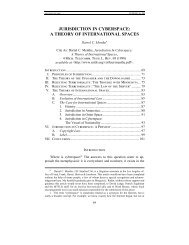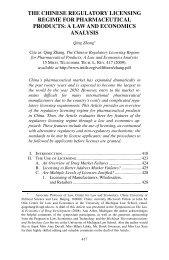Fracking Patents - Michigan Telecommunications and Technology ...
Fracking Patents - Michigan Telecommunications and Technology ...
Fracking Patents - Michigan Telecommunications and Technology ...
- No tags were found...
Create successful ePaper yourself
Turn your PDF publications into a flip-book with our unique Google optimized e-Paper software.
310 <strong>Michigan</strong> <strong>Telecommunications</strong> <strong>and</strong> <strong>Technology</strong> Law Review [Vol. 19:279that “it was difficult to arrive at a ‘short list’ of chemicals that would beinformative for water quality monitoring because of the vast array of productsconstantly being developed, <strong>and</strong> the wide selection of chemicals used inthose products.” 205 Others have reached similar conclusions: “Because of thelack of disclosure by the drilling companies of the individual chemicals withtheir unique CAS registry numbers used in fracking fluids, it is difficult totruly assess their potential adverse effects, <strong>and</strong> so the cumulative exposureimpact is not known.” 206In another study, the New York State Department of EnvironmentalConservation (“NYDEC”) analyzed 235 hydraulic fracturing products fromsix oilfield service companies <strong>and</strong> fifteen chemical suppliers. 207 It could onlydetermine the complete composition of 167 products. 208 Among the products,322 unique chemicals with CAS numbers were identified. 209 Part of thedifficulty was that “a significant number of product compositions have beenproperly justified as trade secrets within the coverage of disclosure exceptionsof the Freedom of Information Law,” however, the NYDEC “considersMSDSs to be public information ineligible for exception from disclosure astrade secrets or confidential business information.” 210 As a further difficulty,the NYDEC found that “compound-specific toxicity data are very limited formany chemical additives to fracturing fluids.” 211 As a result, it was forced tolimit its assessment to “qualitative hazard information.” 212In sum, given the widespread absence of necessary data, “it has beenscientifically difficult to establish causal relationships between oil <strong>and</strong> gasactivity <strong>and</strong> health effects.” 213 Nonetheless, the lack of specific evidence“does not negate the fact that oil <strong>and</strong> gas operations use <strong>and</strong> produce toxiccontaminants that adversely affect human health, nor does it negate the potentialhealth effects of the large-scale socio-demographic <strong>and</strong> economicchanges often associated with such projects.” 214 In place of answers, thereare “many uncertainties” regarding the health effects of the oil <strong>and</strong> gasindustry. 215205. Id. at 1049.206. Finkel & Law, supra note 183, at 785.207. N.Y. STATE DEP’T OF ENVTL. CONSERV., REVISED DRAFT SUPPLEMENTAL GENERICENVIRONMENTAL IMPACT STATEMENT ON THE OIL, GAS AND SOLUTION MINING REGULATORYPROGRAM 5-41 (2011).208. Id.209. Id.210. Id. at 5-63.211. Id.212. Id. at 5-74.213. Witter et al., supra note 148, at 5.214. Id. at 7.215. Id. at 28.






